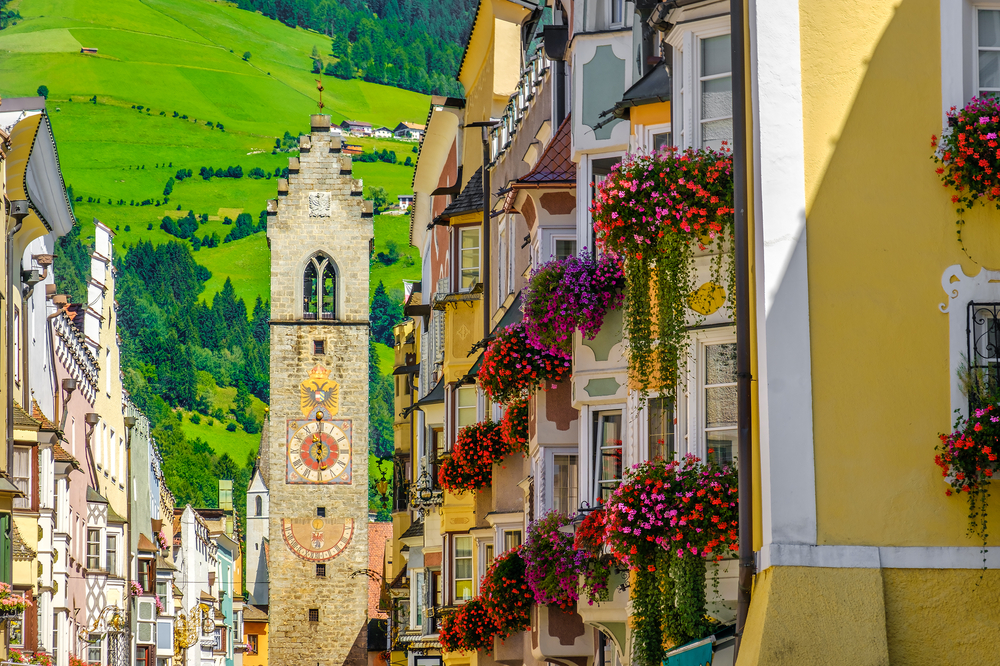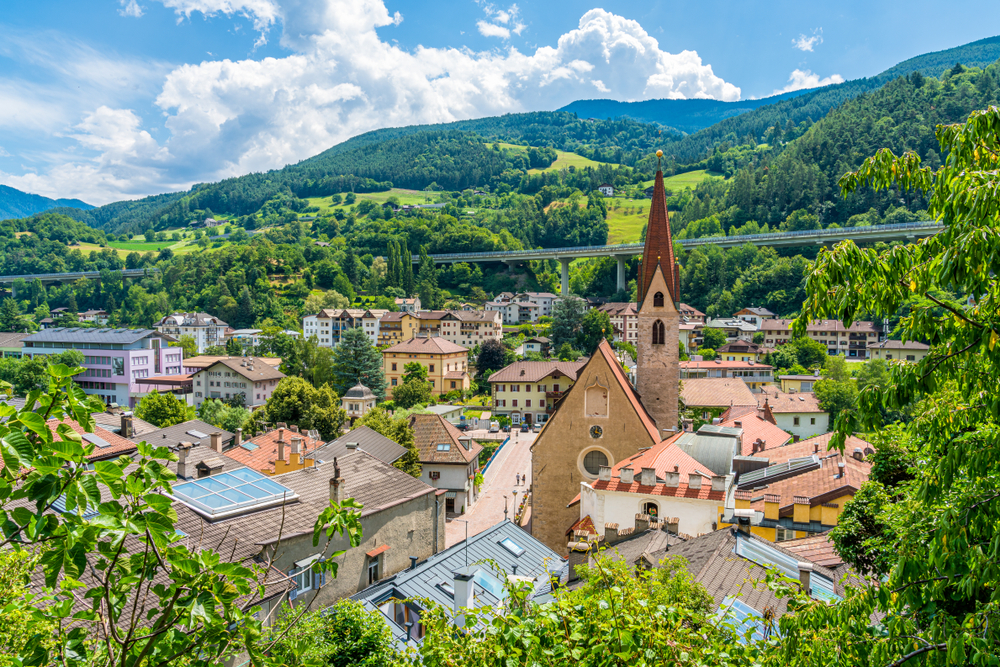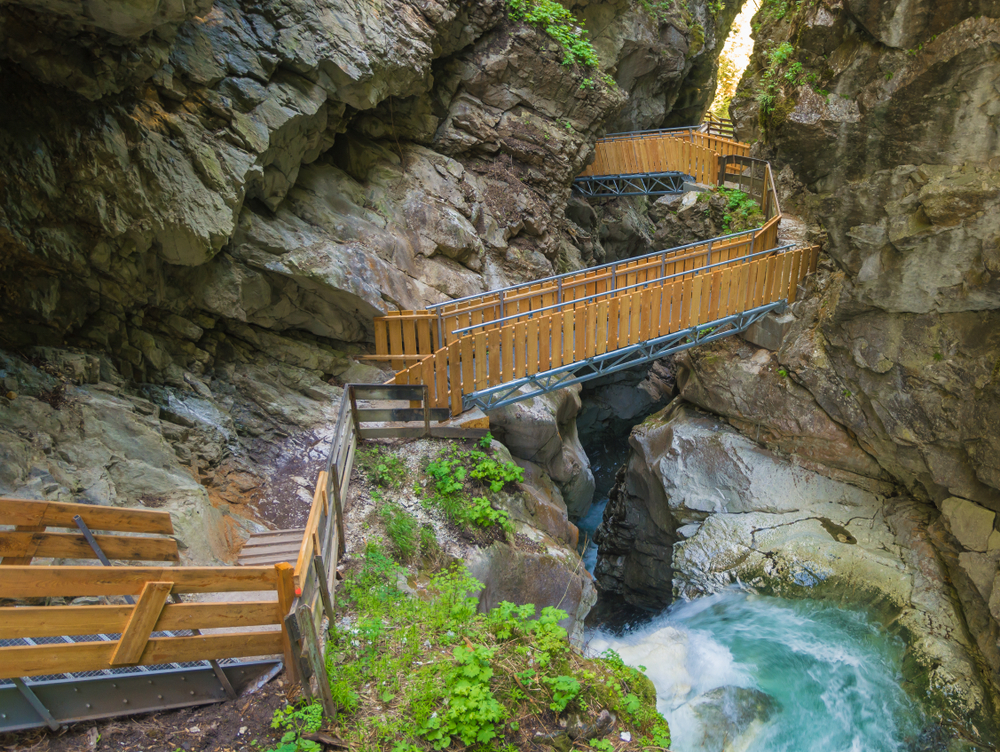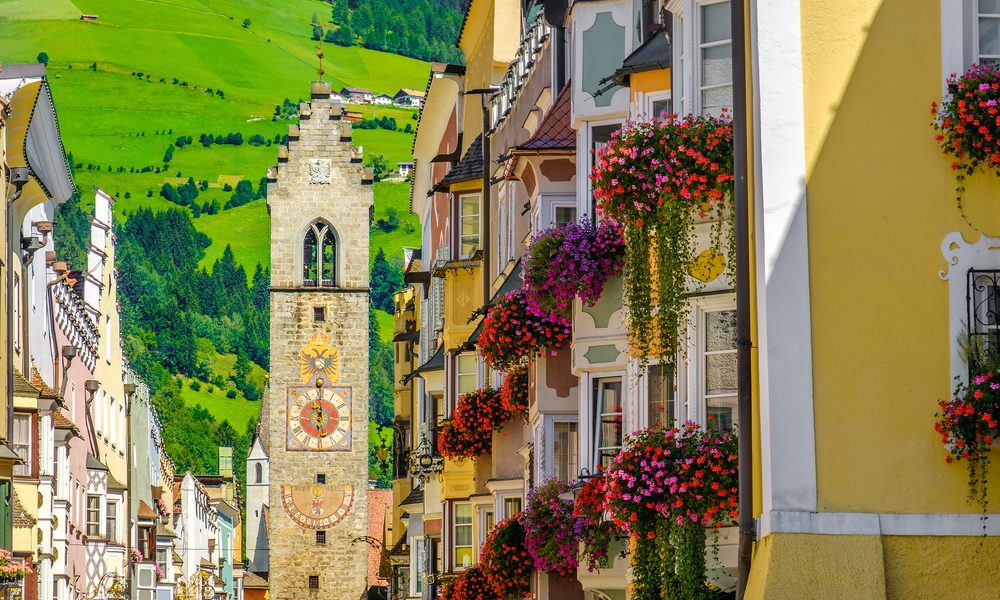Vipiteno is an Italian town of 6.980 inhabitants in the autonomous province of Bolzano in Trentino-Alto Adige. The town is part of the circuit of the most beautiful villages in Italy and it is located at 948 meters above sea level.

Vipiteno is one of the most beautiful towns in Italy. Over the centuries, it was repeatedly the residence of emperors. Today, the medieval town has become quite modern, however retaining its origins and its medieval air. Picturesque protrusions and cusps, colorful facades and suggestive corners decorate the main street, where the civic tower delimits the border between the new city and the historic center. A good number of shops and hotels line the main street.
The name Vipiteno is documented for the first time as early as 1180. Mainardo II, Count of Tyrol, gave the settlement city rights in 1280 and expanded its historic center.
The town had its first flowering at the beginning of the 15th century with the advent of mining in the Wipptal, in the Upper Isarco Valley. Many “entrepreneurs” of this era protomodern settled in Vipiteno. Many of the characteristic buildings and facades of town houses date back to this era. The Torre delle Dodici, the symbol of the city, was also built at the end of the 15th century. Today Vipiteno is a modern town with a fervent commercial activity. All its delicatessen shops and Italian boutiques, as well as Central European cafes and typical restaurants around the historic 15th-century Torre delle Dodici, give this town of 7000 inhabitants a Mediterranean charm combined with its long history. Tyrolean. It is no coincidence that the historic center is considered one of the most beautiful places in Europe for shopping.
The valley station of the 6-cabin cable car is located just five minutes from the pedestrian zone of Vipiteno and takes 15 minutes to the leisure mountain – Monte Cavallo. The lateral valleys to that of Vipiteno are today famous holiday destinations with an excellent offer of 4-star guesthouses, farmhouses and wellness hotels. For those who want to spend a holiday full of activity, the Alpe dello Ziller glaciers offer easy and demanding routes, for mountain bikers there are well-marked trails and forest roads for adventurous tours.
Let’s discover this beautiful town together!
Torre delle Dodici
One of the attractions of Vipiteno – in addition to its churches, several museums and the town hall with the Stele of the god Mithras and the Roman stone – is the Tower of the Twelve (Zwölferturm), which separates the historic center from the new district of the city. The tower represents not only the emblem of Vipiteno but, with its height of 46 meters, also its tallest building. The name probably derives from its bell which calls the citizens to the midday lunch break (“at twelve”).
Torre delle Dodici was erected between 1468 and 1472 above the passage through the historic center, and used as a city gate. During this period, the silver mine of the nearby Val Ridanna donated a prosperous period of growth to Vipiteno (Sterzing), and also attracted the most important German family of entrepreneurs between the late Middle Ages and the beginning of the modern age, the Fuggers. . Nowadays, above the arch of the door there are two marble slabs that recall the laying of the first stone by Sigismondo of Austria, in 1469. In 1867 a fire destroyed the Gothic spire of the Tower of the Twelve, which was replaced in the following years from the current stone roof.
For many years the building, which offers a spectacular view of the town, was also the headquarters of the fire brigade. Nowadays, Torre delle Dodici is accessible only on certain days of the year, in December the stalls of the suggestive Christmas Market are located right under it. And how do you reach the tower? It rises between the historic center and the new town, nearby there are the Centrum car park or the underground car park in Piazza Europa.
Church of Santo Spirito
Already around 1400, in the Upper Isarco Valley, mining began in the mines and the city of Vipiteno experienced a rapid flowering. Thanks to the lively north-south traffic, it was also necessary to make miners, pilgrims and travelers available, as well as accommodation, also places to rest and refresh themselves.

Thus, in 1388, the hospital of Vipiteno was built outside the Brenner gate which, a few years later, was transferred to the town square due to the danger of flooding.
The fact that in the past the hospital was of considerable importance is also evident from the coat of arms of the city, in which a pilgrim with a hanger and rosary crown is represented under the eagle.
What was once the hospital church, also known as the Church of Santo Spirito, was built in 1399 and still remains one of the best preserved Gothic churches in all of South Tyrol.
The colorful cycle of frescoes by the master Giovanni da Brunico, father of the famous pictorial school of the Val Pusteria, dates back to 1415 and represents the Annunciation, the Mount of Olives, the kiss of Judas, Christ before Pilate, the scourging, Christ who brings the cross and the resurrection, while the west wall portrays the Last Judgment.
Over the years, the interiors of the church underwent modifications and the fine frescoes were covered with other paintings.
They were brought to light only in 1939, on the occasion of a restoration. In the years 1984-1989 the church underwent further renovations with the patronage of the provincial Superintendency for the protection of cultural heritage: it was then that the frescoes were cleaned of subsequent paintings and definitively restored to their former glory.
Multscher Museum
The Multscher Museum is located in Via della Commenda of the Teutonic Order in the southern area of Vipiteno, next to the parish church dedicated to “Our Lady of the Marshes”. In addition to the famous doors of the altar by Hans Multscher there are also other parts of the ancient high altar of Vipiteno, including a fragment of the altarpiece, four drapery angels, the great standing figures of San Giorgio and San Floriano and the busts of two prophets.
The museum also houses some pieces from the former civic museum, including several chests and coats of arms of the guilds that belonged to the ancient artisan families of Vipiteno.
Weights and measurements for salt, oil and cereals to facilitate the introduction of the capacity measurement unit under Empress Maria Theresa, as well as a calibration bench for length and capacity measurements.
Noteworthy is also the so-called “Grafenzimmer”, in which the ceiling is decorated with precious frescoes of four different monastic orders from South Tyrol, while the walls represent an overview of the Vipiteno valley with important historical and artistic references.
In the chapter room, the visitor can admire a particularly valuable wooden cladding and a coffered ceiling with rosettes.
Directly connected to the museum and therefore to be visited together with it is the Church of Santa Elisabetta, a late Baroque church built in 1733 by the important Baroque architect Giuseppe Delai for the Teutonic Order.
Castel Tasso
Castel Tasso (in German Schloss Reifenstein) is a castle that rises in the municipality of Campo di Trens, at the southern entrance of the Vipiteno basin, in the province of Bolzano. Just in front of the castle, on the other side of the valley, there is Castel Pietra.
The castle is one of the oldest, historically important and richest in South Tyrol and is one of the best preserved medieval castles in the area.
It rises above a hill overlooking a plain, obtained from a former reclaimed marsh (Sterzinger Moos), on which a small military airport was built, now used only for tourism purposes.
The castle was mentioned for the first time in documents written in 1100 as a fief of the Bavarian Counts Lechsgemünd, while from 1140 the fortress was given to the Lords of Stilfes.
In the following centuries several counts and nobles lived in the manor, until in 1405 the property passed to the family of the Lords of Sabiona (Säben). After their extinction, the castle became a possession of the Duke Sigismondo of Austria, who, however, in 1470 sold it to the Teutonic Order, to which much of the current appearance and furnishings are due. Finally, since 1813 it has been owned by the Counts Thurn und Taxis of Regensburg (hence the Italianized name “Tasso” of the castle, used since the 1930s).
Today Castel Tasso is considered one of the most precious castles in South Tyrolean history. Since the castle was never conquered or devastated, it is still well preserved today and there are many ancient objects and furniture inside. The small chapel of San Zeno is also part of the structure, where eight coffins of baiuvar wood dating back to the 4th and 8th centuries were found, two of which can be seen in a room in the castle, while the other six are kept in the Museum archaeological site of South Tyrol with human remains inside.
Inside Castel Tasso, you can visit 10 rooms in perfect state of conservation, among which we remember: a large thirteenth-century kitchen with an open fireplace, the old dwelling tower, a dark prison 5 meters deep and also the famous and precious “Green Room” (Grüner Saal), which in the decorations with its characteristic green color, also hides different characters. All this is an evocative example of a medieval fortress, which Castel Tasso was in times gone by.
Guided tours are held from Easter to early November.
Waterfalls of Stanghe

If you follow the path that leads along the Rio Racines from the hamlet of Stanghe near Racines in the Upper Isarco Valley, you reach a small and fascinating gorge, the so-called Gola di Stanghe, or Gilfenklamm (in German). This gorge was opened in 1896 and obtained the name “Kaiser-Franz-Josefs-Klamm” (Gorge of Emperor Franz Joseph of Austria) two years later. To this name he still remembers a small commemorative plaque along the path.
Over the centuries, the Rio Racines has dug deep underground paths. At the center of the 2.5 km long gorge, dizzying glances await you in depth – the path takes you in about an hour for bridges and steps through this natural spectacle, which is open from early May to early November.
Here, in Val Racines, marble was excavated in times gone by as still today. Also this gorge has carved its path in 15 m depth through the marble: in some parts you can see the clear and white color, while in others it has green reflections. Did you know that a large part of the marble used for the construction of the Innsbruck Court Church with its famous “Black Men” comes from South Tyrol?
Exactly from the Stanghe Gorge, the only gorge in Europe entirely carved out of pure white marble!
The parish church “Madonna della Palude”
The Parish of Our Lady of the Swamp is located a little outside the city center, at the southern exit of the city. The choir of the gigantic Hallenkirche (“hall” church) dates back to the 15th century, the hall to the 16th century.
White marble was used for the majestic columns of the interior. Richly decorated is the southern portal of the church, designed by Mattheis Stöberl, which bears an inscription commemorating the laying of the foundation stone for the hall by Emperor Maximilian in the year 1497. The baroque frescoes of the vaults are by Adam Mölk.
The church is the tallest church between Monaco and Verona; measuring 32 meters in height, the nave is 38 meters long and 23 meters wide. It was built on the remains of a Romanesque church near the Roman cemetery, the testimony of which was the discovery of the mortuary plaque of Postojna Victorina now exposed on the north wall of the nave.
The works, directed by Hans Feur, began in 1417 and were completed in 1451, while the Gothic altar, 12 m high, by the sculptor Hans Multscher of Ulm was placed in 1458. In 1497, work began to expand the nave, under the direction of Hans Lutz of Schussenried, inserting a colonnade of white marble from the nearby Racines valley, the works ended in 1525.
In 1753, the church was subjected to a new makeover by removing the Gothic parts and replacing them with Baroque enrichments and frescoes by Joseph Adam Ritter von Mölk.
Jöchlsthurn Palace
Jöchlsthurn Palace (in German only Jöchlsthurn or, more rarely, Jöchlsturm) is a fortified palace located in Vipiteno (BZ), not far from the city walls and the Tower of the Twelve (Zwölferturm). Today, it houses the Provincial Mining Museum, and there are collections of evidence of life in the mines in the area from the Middle Ages to the modern era.
This is not a real castle, but a stately 15th century residence, enlarged several times over the centuries, and which nevertheless retains its appearance thanks to the battlements and the particular shape.
It owes its name to the Jöchl family, originally from Stegona (today in the municipality of Brunico), who moved to Vipiteno in 1460 to take care of their mining interests in Monteneve (Schneeberg), buying what – at the time – was only a crenellated tower (today the central part of the building).
And its shape owes the second part of its name (both Thurn and Turm indicate a tower), the name with which the Jöchl were ennobled with the title of Jöchl von Jöchlsthurn. The works and extensions that the family carried out over a century gave the Jöchlsthurn substantially its current appearance.
In 1643, the castle passed to the Counts Enzenberg, who still own it today. From 1836 and until the eighties of the twentieth century the palace was the seat of the magistrate’s court, both under Austria-Hungary and under Italy.
Particularly noteworthy are the 15th-16th century frescoes, the late Gothic wooden ceilings (15th century) and the chapel.
A Jöchl epitaph is found today in the National Gallery of Dublin in Ireland.






